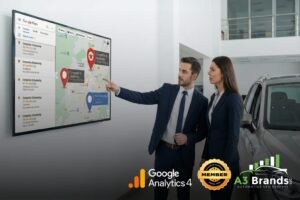Your paid ad costs are climbing. Your cost per lead is creeping higher every quarter.
And you’re wondering how long you can keep writing checks to Google and Facebook before your margins completely disappear.
Here’s the reality: the average dealership is spending $528,923 per year on advertising, with an average cost per lead around $250. Meanwhile, paid channel CPL averages $42.95 and keeps climbing. You know these numbers aren’t sustainable.
But here’s what stops most dealers from doing anything about it: fear of losing leads. You can’t afford to “figure out SEO” while your lead volume tanks. We get it—that’s exactly why we built this plan differently.
At A3 Brands, we’ve guided dozens of dealerships through this exact framework. This isn’t about abandoning paid ads. It’s about proving organic can deliver while your paid channels keep running as a safety net. In 90 days, you’ll have data—not hope—to decide whether to scale, iterate, or roll back.
This plan works because it’s designed around checkpoints at 30, 60, and 90 days with clear decision rules at every gate. If organic hits your thresholds, you gradually shift budget. If it doesn’t, you revert instantly. No gambling. No guesswork.
Let’s get into it.
⚡ Quick Wins You Can Start This Week
Before you dive into the full 90-day plan, here are 5 things you can do RIGHT NOW to start seeing organic results:
- Claim and optimize your Google Business Profile – Add photos, update hours, respond to reviews, enable messaging (can show results in 7-14 days)
- Audit your top 10 vehicle landing pages – Are they thin manufacturer descriptions? Add 150-200 words of local, dealership-specific content
- Check your mobile site speed – Use Google PageSpeed Insights. If it’s over 3 seconds, compress images and enable caching immediately
- Set up call tracking – Implement Dynamic Number Insertion so you can actually prove which leads come from organic vs. paid
- Fix your NAP consistency – Check your top 10 citations (Google, Yelp, Facebook, etc.) and ensure Name, Address, Phone are identical everywhere
These five actions can start generating measurable results while you plan the full rollout.
Understanding the 90-Day SEO Framework
Why Controlled Testing Matters
Here’s what we’ve learned after 20 years in automotive marketing: asking dealers to abandon proven paid strategies is a non-starter. So we don’t ask.
Instead, we run organic testing in parallel with your existing campaigns. SEO has to earn its budget by demonstrating measurable performance—just like every other channel. This parallel approach respects your investment in paid advertising and gives stakeholders the psychological safety they need to greenlight the test.
Look, we get it. Dealerships are allocating 73% of their $543,539 annual advertising budget to digital channels—that’s up from 65% just two years ago. And when you’re spending that kind of money on paid, the pressure to maintain lead flow is intense.
The 90-day timeline works because it aligns with your quarterly reporting cycles. It gives you natural decision points that GMs and finance teams already understand. By treating SEO as a scientific experiment—with control groups, baseline metrics, and success criteria defined upfront—you move from “let’s try this” to “here’s what the data says.”
This plan reframes SEO from a six-month gamble into a repeatable, controllable process. You maintain your safety nets while proving organic value through staged, measurable steps.
The result?
You preserve lead flow and professional credibility while unlocking sustainable organic gains that compound over time.
How We Mitigate Risk Through Parallel Operations
Risk mitigation isn’t a nice-to-have — it’s central to adoption.
We use graduated commitment instead of all-or-nothing transitions. Your paid spend stays untouched initially while SEO foundations are set. Incremental budget reallocation begins only after you hit predefined milestones. And we build in rollback triggers—objective KPI thresholds that automatically revert changes if things aren’t working. This removes emotion from critical decisions and protects everyone’s reputation.
Governance matters just as much as tactics. Roles, responsibilities, and approval authorities need to be documented in your project charter upfront. With clear gates and transparent data, you reduce the political and operational friction that typically kills experimentation before it can prove itself.
📊 Staged Reallocation Timeline
Days 0–30: No paid cuts whatsoever. You’re laying foundations and validating tracking.
Days 31–60: Test a 10–15% reallocation on low-risk keywords with A/B tapering to confirm organic can cover the gap.
Days 61–90: If organic leads meet thresholds, expand to 20–25% reallocation while keeping immediate rollback options ready.
This approach lets you validate organic coverage by intent segment while maintaining the ability to restore paid tactics instantly if needed.
Pre-Launch Foundation (Week 0)
Technical SEO Audit and Baseline Metrics
You can’t improve what you don’t measure. A thorough technical audit and baseline metrics aren’t optional—they’re the foundation of everything that follows.
Most dealerships already have meaningful organic traffic (typically 15–25% of site traffic) that’s being underutilized. The audit should classify issues by effort versus impact so you can prioritize early wins that build momentum.
Baseline data you need to capture:
- Current organic traffic volume and sources (GA4)
- Keyword visibility for branded, model, and service terms
- Local pack and Google Business Profile performance
- Page load speeds and Core Web Vitals
- Mobile usability scores
- Current organic lead attribution (calls, forms, chat)
- Competitor organic visibility benchmarks
Prioritize fixes that unblock indexing and improve user experience—these deliver the fastest measurable lift. We had a Dallas dealer whose service pages were stuck on page two of Google.
After minor content updates and GBP optimization, they saw a 40-appointment monthly lift within 30 days.
Stakeholder Alignment and Governance Structure
Stakeholder alignment goes beyond PowerPoint presentations. You need psychological safeguards that preserve dignity and make it safe for decision-makers to say “yes” to experimentation.
The project charter should be your single source of truth. It needs to include:
- Executive sponsor with final decision authority
- Single project owner responsible for day-to-day execution
- Cross-functional team (SEO lead, sales rep, finance rep, IT lead)
- Weekly review cadence and stakeholder dashboard access
- Escalation and communication protocols
- Budget authority limits and approval workflows
- Clear exit criteria and rollback procedures with dignity-preserving language (frame rollbacks as data-driven iterations, not failures)
One more thing: educate your sales and service teams on how organic leads differ from paid leads. Car buyers spend an average of 14 hours and 19 minutes researching online (with 7 hours and 13 minutes specifically online) before they ever contact you. Organic prospects often arrive earlier in their journey and need different nurturing than someone who clicked a “Get Pre-Approved Now” ad.
Training reduces internal friction and improves conversion performance across the board.
Phase 1: Foundation Building (Weeks 1–30)
Local SEO Optimization
Local search is your fastest path to measurable leads. Period.
Google research shows that 46% of all searches include location-specific intent, and 84% of consumers trust online reviews as much as personal recommendations. GBP changes can show impact in 7–14 days, providing the early validation stakeholders need to stay confident in the plan.
Local SEO extends way beyond correct NAP (Name, Address, Phone). You need reputation management, photo optimization, citation depth across directories, and proper local schema implementation.
🎯 Weeks 1–10 Local SEO Priorities
- Claim and fully optimize your Google Business Profile (attributes, hours, photos, posts)
- Implement a review response protocol across all platforms
- Audit and correct your top 30 local citations
- Create location-specific landing pages if you have multiple stores
- Implement local schema and optimize for “near me” searches
Technical Improvements and Site Speed
Technical blockers prevent early wins regardless of how good your content is. Fix them immediately.
Focus on reducing page load times and improving mobile experience—both affect rankings and conversion. Site speed issues are particularly problematic for dealerships because inventory pages are image-heavy, and slow load times kill conversion rates.
High-impact technical fixes:
- Lazy load inventory images and compress media files
- Minimize and combine CSS/JS; remove render-blocking scripts
- Implement caching and CDN where appropriate
- Resolve duplicate content and canonicalization issues from inventory feeds
- Fix broken links and redirect chains
Content Strategy for Vehicle Pages
You need to differentiate your inventory with locally relevant, dealership-specific content. Use templates that combine automated data with humanized value propositions to scale without creating thin, duplicate content.
Vehicle content framework:
- 150–200 word model/category introductions with unique local context
- Dealer benefits, customer testimonials, and local financing/incentive details
- Model comparison content and local availability notes
- Service history and certification details where relevant
Extend this with model research hubs that capture mid-funnel traffic and build long-term topical authority.
Phase 2: Acceleration and Testing (Weeks 31–60)
Scaling Content Production
You’re past setup. Now it’s time to scale systematically.
Create workflows that leverage your internal subject matter experts—your service techs and sales reps know what questions customers actually ask. Use content templates to maintain quality at scale without burning out your team.
Scaling tactics:
- Publish 2–3 cornerstone pieces weekly
- Convert sales Q&As into FAQ pages
- Produce localized area pages and seasonal content (winter tire tips, summer road trip prep)
- Create video content for high-interest models
- Implement a content calendar with clear ownership for review and publishing
Consistency beats perfection in content—always.
Advanced Local SEO Tactics
Move beyond city-level optimization. Target neighborhoods, zip codes, and hyper-local intent that your competitors are ignoring.
Advanced tactics:
- Neighborhood landing pages with micro-local keyword targeting
- Partnerships with community organizations for links and citations
- Voice search optimization (conversational FAQ content)
- Local event and offer schema for promotions and seasonal campaigns
Multi-location dealers should treat each store as a unique market while maintaining brand standards. This approach lets you dominate local search across entire regions instead of just ranking in your primary city.
Implementing Structured Data
Invest in automotive-specific schema (Vehicle, Offer, Review) to unlock rich snippets and higher click-through rates. Structured data helps search engines better understand your content and can display car prices, photos, model years, and reviews directly in search results.
Implementation focus:
- Vehicle schema for specs and VIN data
- Offer and event schema for promotions and service specials
- Review schema to surface star ratings in search results
Dealers who go beyond basic Organization schema gain a visible advantage. Structured markup drives significant incremental clicks—we’ve seen CTR improvements of 20-30% on pages with proper schema implementation.
Phase 3: Optimization and Scale (Weeks 61–90)
Conversion Rate Optimization
You’ve earned the traffic. Now convert it.
Organic visitors differ in intent from paid traffic. They’re often earlier in the journey and require tailored engagement paths. Build progressive experiences that nudge research-phase visitors toward conversion without being pushy.
CRO tactics:
- Intent-specific landing experiences (research content vs. transaction-focused pages)
- Progressive engagement flows and dynamic CTAs
- Soft conversions (downloadable buying guides, appointment scheduling, trade-in estimators)
- Trust signals (certifications, testimonials, transparent pricing)
- Chat triggers and form optimization tailored to organic traffic behavior
Link Building and Authority Development
Develop regional authority with high-quality, contextually relevant link strategies. Community sponsorships, local PR, vendor relationships, and genuinely useful content outperform low-quality directory submissions every time.
Link tactics:
- Reclaim unlinked brand mentions (your dealership gets mentioned without links—reach out and ask for them)
- Forge links through community sponsorships and local PR opportunities
- Create data-driven resources or seasonal guides that attract natural links
- Enable staff expertise as thought-leadership content (service tips, maintenance guides)
An evergreen winter driving safety guide that earned dozens of high-quality local links can become a dependable source of monthly traffic and credibility. These assets compound over time.
Competitive Analysis and Gap Identification
Systematic competitive audits reveal where competitors are neglecting mid-funnel content or niche segments. Use this intelligence to focus your content and technical investments on high-opportunity gaps.
Competitive framework:
- Identify top organic competitors and analyze their content gaps
- Analyze backlink profiles and technical strengths
- Map keywords competitors ignore (language preferences, neighborhood terms, specific service issues)
- Prioritize opportunities by business impact and implementation cost
Example: A dealer in a heavily Hispanic market captured significant incremental leads by developing bilingual content for searches competitors completely ignored. Don’t overlook segment opportunities in your market.
Measuring Success and ROI
Key Performance Indicators
A robust KPI structure balances short-term signals with long-term outcomes so stakeholders stay confident throughout the plan’s natural ramp period.
📈 KPI Timeline at a Glance
Weeks 1–30 (Foundation):
- Technical fixes completed
- GBP metrics (views, calls, direction requests)
- Number of local citations corrected
- Content pieces published
- Baseline traffic trends
Weeks 31–60 (Acceleration):
- Rank improvements for target keywords
- Percentage organic traffic growth
- Engagement metrics (pages per session, time on page)
- Initial lead attribution from organic sources
Weeks 61–90 (Optimization):
- Organic lead volume
- Organic conversion rate
- Cost per lead for organic traffic
- Sales attribution uplift
- Full ROI calculation
Translate SEO metrics into business outcomes. Present cost per lead, lead volume, and showroom visits alongside organic traffic so non-technical stakeholders see the financial impact clearly.
Tracking Organic Lead Generation
Capturing true organic contribution requires a complete tracking stack and CRM integration. Undercounting organic leads is extremely common without proper attribution infrastructure.
Tracking checklist:
- GA4 configured with conversion events and server-side tagging
- Consistent UTM taxonomy and campaign naming standards
- Dynamic Number Insertion (DNI) for phone call attribution
- Form hidden fields that preserve source and medium data
- Chat and transcript integration that captures traffic source
- Walk-in capture fields and sales rep attribution practices
- CRM mapping to maintain source data through the sale
- Offline conversion imports back to GA4
Advanced attribution modeling often uncovers organic influence far greater than last-click models reflect. This shifts budget conversations dramatically when stakeholders see the full picture.
Demonstrating Reduced Paid Spend Opportunities
Safe, surgical paid reductions come from identifying paid keywords where you already have organic top-3 rankings capturing the majority of demand. Controlled pause tests with A/B tapering validate whether paid spend is truly necessary or just redundant.
Paid reduction approach:
- Map paid spend against organic ranking and share of impressions
- Pause or reduce low-risk, redundant keywords for short test windows (14 days)
- Measure total lead volume and CPL during the test
- Scale successful tests and reallocate savings to conquest or awareness campaigns
Real outcomes: Dealers commonly find 20–30% of their paid spend can be shifted without harming total lead volume. That frees up budget for higher-value paid strategies or drops straight to the bottom line.
Quick Week-by-Week Roadmap
Week 0: Complete audit, establish baseline metrics, finalize project charter, configure tracking stack
Weeks 1–2: Fix critical technical blockers, fully configure GBP, implement call tracking with DNI
Weeks 3–4: Publish first content sprint (vehicle pages + FAQs), correct top 30 citations
Weeks 5–10: Continue local SEO execution, prioritize service and research content
Weeks 11–20: Site speed optimization, canonical cleanup, structured data implementation
Weeks 21–30: Launch model research hubs and scaled content templates; prepare paid taper experiments
Weeks 31–45: Run A/B paid taper tests, expand content velocity, deploy advanced local tactics
Weeks 46–60: Complete structured data rollout, refine tracking attribution, conduct mid-project performance review
Weeks 61–75: Execute link building campaigns, run CRO tests, refine intent-based user journeys
Weeks 76–90: Close competitive gaps, finalize ROI reporting, make scale vs. rollback decision
Frequently Asked Questions (FAQs)
1. How much of our paid budget can we realistically cut in 90 days?
Most dealerships find they can responsibly reduce paid spend by 15-25% within the first 90 days without impacting total lead volume. The key is gradual testing—start with 10-15% reductions on low-risk, high-organic-ranking keywords, validate performance, then scale. We’ve seen dealers eventually shift 30-40% of paid budget once organic assets mature past the 90-day mark.
2. What if organic doesn’t deliver enough leads after 30 days?
That’s exactly why we build in rollback triggers. If organic lead volume doesn’t hit 80% of your baseline threshold and CPL exceeds your target by more than 10%, you simply restore paid spend to the original level. The beauty of this framework is that you’re testing with safety nets—not gambling. You decide at each gate based on data, not hope.
3. Do we need to hire an SEO agency or can we do this in-house?
It depends on your internal resources. You’ll need someone who understands technical SEO, local optimization, content strategy, and analytics. Most dealerships either partner with a specialized automotive SEO agency like A3 Brands or dedicate 1-2 internal team members plus contractor support for content production. The key is having a single project owner with clear accountability.
4. How long does it actually take to see organic leads from SEO?
Local SEO tactics (GBP optimization, citations, reviews) can generate calls and direction requests within 7-14 days. Technical fixes and content improvements typically show measurable traffic increases within 30-45 days. However, significant lead volume that allows you to reduce paid spend usually materializes between days 45-75. That’s why we use a 90-day framework with staged checkpoints.
5. What’s the biggest mistake dealerships make with SEO?
Cutting paid spend too aggressively before organic is ready to cover the gap. The second biggest mistake is not properly tracking organic lead attribution, which leads to undercounting organic contribution and continuing to overspend on paid. Both are solved by following the framework: validate tracking first, test paid reductions gradually, and make data-driven decisions at every gate.
6. Will this work for a small single-location dealership?
Absolutely. In fact, single-location dealerships often see faster results because you’re optimizing for one specific market rather than managing multiple locations. Your local SEO efforts are more focused, your content is more targeted, and your tracking is simpler to implement. The framework scales down perfectly for smaller operations.
7. What if our website is on a vendor platform we can’t fully control?
Many dealerships face this challenge with DMS-integrated website platforms. Focus on what you CAN control: Google Business Profile optimization, citation management, review generation, and off-site content (blog, resource pages). Then work with your vendor to implement technical improvements like site speed optimization, schema markup, and proper canonicalization. Even partial implementation of this framework delivers measurable results.
8. How much should we budget for this 90-day plan?
Budget varies based on whether you’re doing this in-house or with an agency. Expect $5,000-$15,000 monthly for agency partnership (which includes strategy, implementation, content, and reporting), or $3,000-$8,000 monthly for contractor/freelancer support if managing in-house.
Remember, you’re not adding this on top of existing spend—you’re proving organic can replace a portion of your paid budget, creating net savings within 6-12 months.
The Bottom Line
This 90-day dealership SEO plan isn’t theory. It’s a repeatable method for converting organic opportunity into measurable business value.
By combining disciplined governance, rigorous tracking, staged paid-taper tests, and stakeholder-friendly reporting, you can responsibly reduce paid dependency while building durable organic assets that compound over time.
Looking ahead, the competitive edge will belong to dealerships that treat organic search as a strategic channel—not an experimental afterthought. With paid acquisition costs continuing to rise and 95% of car buyers conducting extensive online research, the ability to engineer predictable organic lead pipelines compounds into lasting ROI and competitive advantage.
Here’s the challenge: launch a controlled test now and prove organic can reliably contribute to lead flow within a single quarter—or defer and watch competitors claim the organic real estate that drives lower-cost, higher-quality demand.
The choice isn’t whether to adopt SEO. It’s whether you’ll run disciplined experiments that turn SEO from a theoretical benefit into a measurable business engine.
Ready to Cut Your Paid Spend Without the Risk?
At A3 Brands, we’ve guided dozens of dealerships through this exact 90-day framework—proving organic can deliver while keeping paid channels as your safety net.
Here’s what happens next:
- We’ll audit your current organic performance and paid spend (no cost, no obligation)
- You’ll see exactly where your biggest opportunities are in the first 30 days
- We’ll build your custom 90-day roadmap with clear KPIs and decision gates
- You’ll have weekly reporting that shows leads and dollars—not just rankings
No long-term contracts. No risk. Just a proven framework that either delivers data-backed results or you walk away.
Tim Boyle

What Your PPC Bill Isn’t Telling You: The Real Math Behind SEO vs Paid Search

Why Your Competitor Ranks Higher (And How to Close the Gap)

Your 2026 Digital Roadmap: 3 Data-Backed SEO Shifts Every GM Must Make

Why Dealers Who Started Content Marketing in 2022 Now Pay 40% Less Per Lead

How Dealerships Win Search in 2026 Without Wasting Money on Clicks


